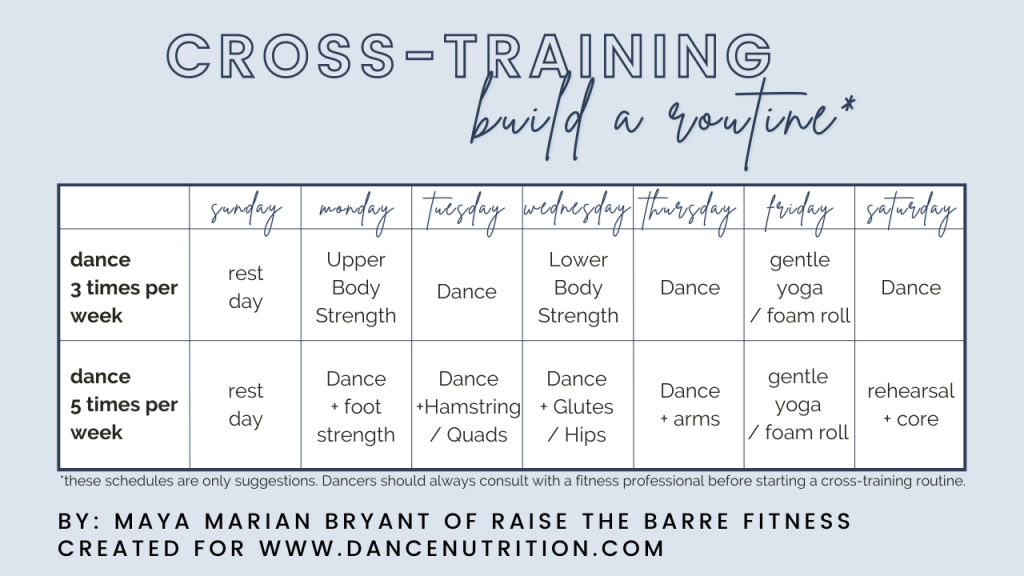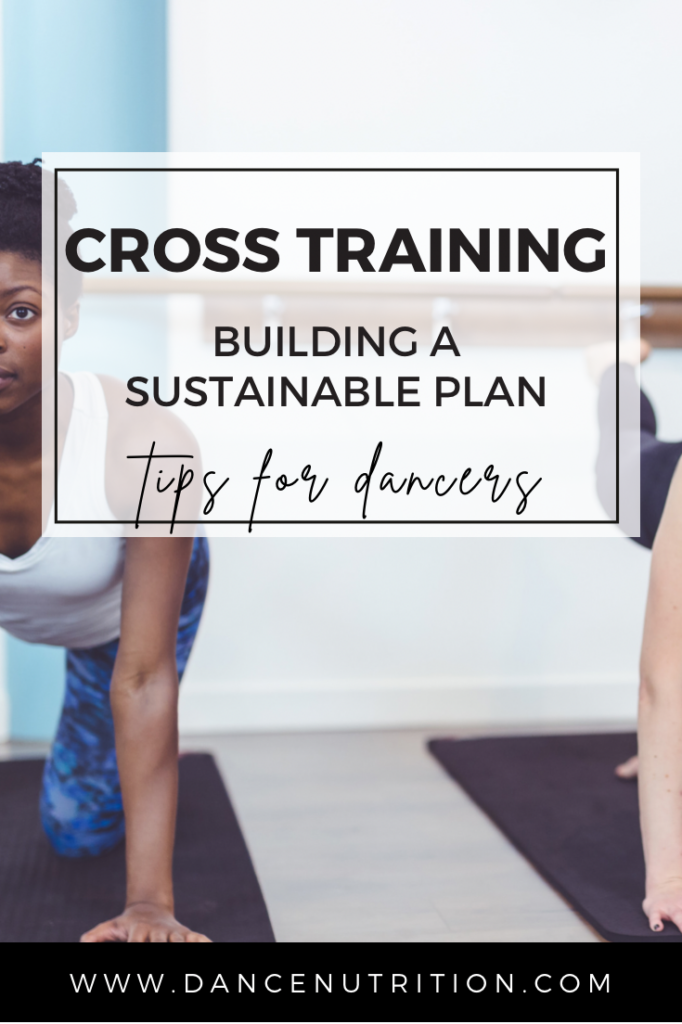Has your dance teacher suggested that you cross-train? Is getting up en pointe a struggle? Are balances a challenge? Are you successful with splits but unsuccessful at getting your leg above 90 degrees? Or, are you lacking core engagement during class? If you answered yes to any of these, then it’s time to consider cross-training.
Supplementing their training with a well-rounded cross-training plan helps dancers prevent injuries and improve performance. In this blog post, fitness trainer Maya Bryant shares everything dancers need to know about building a sustainable cross-training plan as a dancer.
What is Cross-Training?
Cross-training involves intentionally engaging in multiple (usually 2 or more) sports to enhance performance in one’s primary sport or activity. Let’s use runners as an example. While running prioritizes muscular endurance, it also requires muscle strength and strong bones. Runners typically cross-train to delay the onset of muscle fatigue and build bone strength to avoid injuries like shin splints.
The Benefits of Cross-Training for Dancers
We can consider the benefits of cross-training by examining all parts of a typical dance class. Cardio and endurance are required interchangeably, while balance, agility, and flexibility are relied upon throughout. For dancers, cross-training can help:
- Increase flexibility and mobility for extension work.
- Improve cardiovascular fitness for better endurance during long rehearsals and performances.
- Engage the proper muscles needed to propel you onto pointe.
- Improve agility for ease through quick transitions.
- Strengthen balance and stability.
- Prevent overuse injuries by balancing muscle groups and reducing repetitive strain.
- Promote mental well-being through varied workouts that keep training interesting and enjoyable.
Injury prevention is a major benefit for dancers. Many cases of tendonitis, popping, and pinching may be prevented with strength training. With this training comes the ability to move with more care and intentionality. Before building your sustainable cross-training routine, let’s discuss the different types of regimens.
#1: Strength Training for Dancers
Strength training builds muscle endurance, power, and stability. It may be done in multiple forms but generally, includes some form of resistance applied to your body. This encourages your muscles to engage with added force— increasing strength. Contrary to popular belief, this does not just involve weight lighting. Strength training for dancers can also involve:
- Kettlebells
- Resistance Loops
- Resistance Bands
- Bodyweight
- Barbells
- Suspension Weight Training (TRX)
- Medicine Balls
- Slam Balls
- BOSU Balls
- BOSU Balance Trainer
- Resistance Sliders
- And of course the infamous exercise machines and dumbbells
Action step: focus on bodyweight exercises (like planks and push-ups), resistance training (using weights or resistance bands), and functional exercises (such as squats and lunges).
#2: Flexibility, Mobility, and Stability Training for Dancers
Flexibility allows for a greater range of motion, while mobility ensures joints move freely and efficiently. Both are crucial for dynamic movements. Include regular stretching, yoga, and Pilates throughout your week. These practices improve flexibility and core strength, aiding in injury prevention and overall performance.
Stability work can help to improve balance and proprioception (the body’s ability to sense its position in space). Exercises like single-leg stands, stability ball workouts, and balance board exercises are examples.
#3: Cardiovascular Training for Dancers
Cardiovascular fitness enhances stamina, enabling dancers to perform for longer periods without fatigue. Engage in activities that elevate the heart rate, such as running, swimming, cycling, or dance-based cardio workouts.
Developing a Cross-Training Routine
There are four simple steps to consider when creating a cross-training routine for dance:
- Realistic Goals– consider your dance schedule. Does it look like several hours of dance every day? Or maybe classes a couple of times per week? How often and for how long your strength train will be dependent on your current dance schedule. Define clear and achievable goals that align with your physical needs.
- Consistency– this doesn’t necessarily mean you’re cross-training every day. It does mean, however, that you are maintaining the integrity of your plan. Is that just twice per week for 20 minutes? Then be consistent with that! Remember small strides, great distances.
- Joyful Movement– do not force yourself to exercise in ways you hate. Pilates, Barre, Strength-Based Yoga, or Regular ole Strength Training with Dance Focused Moves. Try a handful to identify which you genuinely enjoy and stick with that!
- Progression– challenging your body’s limits promotes increases in strength. This doesn’t mean you’re working yourself to the point of exhaustion. Your workout should not feel impossible or effortless. Progression of exercises will ensure that your bones and muscles continue to be challenged. Here is an example of a plank progression:
- Plank on wall
- Plank on chair
- Plank with arms fully extended
- Plank on elbows
- Plank on Bosu Ball
- Side Plank
- From here, add repetitions— single-leg lift extensions are an example. When planking, drive the knee in, then bring it up to a down arabesque. Another option is in a side plank— bring the leg to passé, then extend a la second before closing.
Cross-Training Example Schedules
Below is a sample schedule— the first depicts a schedule with dance being 3 times per week and the second 5 times per week.

Cross-training shouldn’t be lengthy if dancing five or more days per week. An extra 10-20 minutes before class is effective. Heading to ballet class early to do some clamshells, glute bridges, and planks will help to warm up your core. Those are the simple, yet effective ways to strength train.
When is the best time for a dancer to strength train?
This is individualized and will take exploration. If you’re new to strength training, moderate amounts are encouraged before class to promote muscle engagement and help you warm up for class. After class, you might be fatigued and therefore execute movements improperly.
Remember, building a cross-training routine does not have to be complicated. It will help make your dancing less complicated. Imagine maintaining balances for long periods, not huffing and puffing after center combinations, and having beautiful extensions supported by muscles instead of clenching onto tendons. Simply incorporating strength training for 10-20 minutes a couple of times per week, especially just starting would be sufficient.
Cross Training: Key Takeaways
- Listen to your body: pay attention to signs of fatigue or discomfort and adjust your training to avoid burnout and injuries.
- Make time for rest and recovery: at least one full rest day is encouraged weekly. Light stretching, leisurely walks, and foam rolling can also support muscle recovery.
- Mix it up: keep your workouts varied to maintain interest and address different fitness components.
- Don’t obsess: over-training can risk your performance. Click here to learn more and recognize the signs.
- Seek professional guidance: consult a fitness trainer or physical therapist with experience working with dancers to tailor your cross-training plan appropriately.
Featured post by Maya Marian Bryant, MPH Candidate, NASM-CPT, Certified Barre Instructor. Founder & CEO of Raise The Barre Fitness



